ATSC 3.0 DTV Standard Gets Far East ‘Test Drive’
SHANGHAI, CHINA —History was made here last month as a multinational group of television engineers gathered to perform systems compatibility testing of the ATSC 3.0 digital TV standard. The event, officially dubbed “Plug Fest 2015,” was hosted by China’s National Engineering Research Center of Digital Television (NERC-DTV), Oct. 19-23.
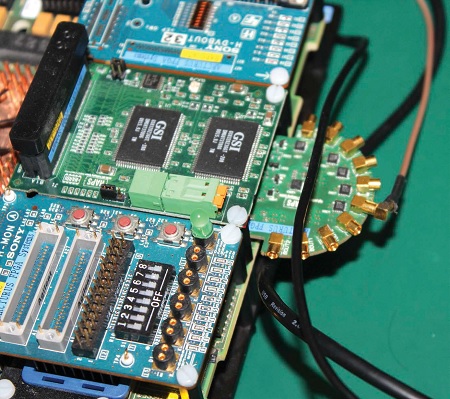
The engineers were convened “to confirm a common understanding of the ATSC 3.0 specifications A/321, A/322 and other relevant standards, and/or working drafts,” according to the Advanced Television Systems Committee, the U.S.-based organization tasked with developing the next-gen broadcast standard.
(A/321 is the standard’s signal discovery and signaling layer and A/322 is its physical layer. In September, A/322 was elevated from “document” status to “candidate standard” and A/321 underwent a similar change in status earlier this year. These elevations signified that specifications were sufficiently in place for construction of hardware and software devices to generate and demodulate the specialized DTV signal.)
The event also included an ATSC 3.0 Bootcamp held at Shanghai’s International Convention Center, which updated attendees on ATSC 3.0’s progress and potential for delivering a high quality television experience. The day-long conference featured keynotes on various aspects of ATSC 3.0 from a number of individuals working closely with the project and attracted more than 150 individuals from some 10 nations.
MAJOR STEP FORWARD
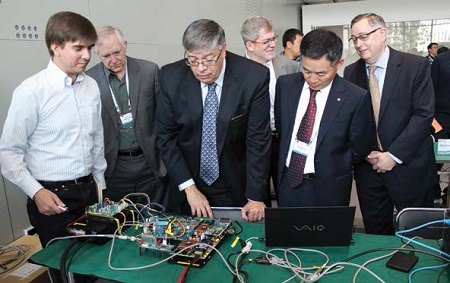
L to R: Lachlan Michael, Lynn Claudy, Glenn Reitmeier, Richard Friedel, Kim Jong Gyu and Mark Richer
The Plug Fest testing is seen as a significant milestone in moving the standard ahead to its 2017 targeted completion date. It was also important because it allowed participating transmitter and receiver companies to exercise a large number of parameters and options designed into the standard, thus proving its flexibility and commercial viability.
Get the TV Tech Newsletter
The professional video industry's #1 source for news, trends and product and tech information. Sign up below.
ATSC President Mark Richer traveled to China along with several other ATSC board members to witness the testing, and was elated with the results. “It was a defining and historical event,” he said. “For me it was not as much about the technology as it was about the collaboration. I think we’ll always remember the incredible cooperation between organizations to make the Plug Fest a reality and to make it successful.”
Lachlan Michael, chair of the ATSC’s S32-2 modulation and coding group, and coordinator of the Shanghai testing event was also pleased with the outcome.
“I would rate it very much a success,” he said. “We had 150 parameter sets that we defined for this Plug Fest and we managed to get through all of those parameters during the week of testing. We achieved all the goals we set out to achieve, we’ve got people talking to each other, we’ve got people working getting more people excited about ATSC 3.0, and we’re just looking forward to the next time when we can get together and show even more features operational.”

Dr. Richard Chernock, chairman of the ATSC Technology Group (TG3) addresses the ATSC Boot Camp, which was held in conjunction with the Plug Fest.
LOW-KEY EVENT Testing took place in a temporary laboratory facility set up by NERC-DTV that measured approximately 30x60-feet. It was filled with workstations occupied by Plug Fest participants Sony, Enensys, Samsung, DekTec, Teamcast, NERC, and Korea’s ETRI (Electronics and Telecommunications Research Institute). Despite the importance of the outcome and the intensity of those participating, the overall atmosphere was surprisingly low-key and subdued.
There were no tall racks, flashing lights, or alarms going off —just assemblages of PCs and relatively small prototyping setups replete with power supplies and an abundance of programmable logic arrays. The comparative silence was broken only occasionally by Michael when he called out in his clear and distinctive Australian accent for testing participants to shift to another mode of operation. All in all, some 70 pages of testing program documents were worked through by the group. Despite the great significance of what was being accomplished there, an outsider who wandered in would only think that he or she had entered a college computer lab.
When Michael announced that testing was at an end, there were no champagne toasts or “high-fives,” just contented smiles on the faces of all those present as they began to break down and pack up their gear. And despite the apparent success achieved, Michael was careful to note that there was still a lot more work ahead for both the ATSC and companies working with the organization in developing the new broadcast standard.
“What we’ve done in this Plug Fest is implement part of the standard,” Michael said. “We haven’t implemented all of the features. Obviously it’s not a complete system yet and there were some issues found on both the modulator and demodulator side, but I think we can say that there were multiple demodulators and multiple modulators that worked for every single combination.”
[The completed standard will also include additional layers and elements addressing such items as synchronization, video and audio standards, A/V content watermarking, delivery signaling captioning and subtitling of content, user personalization, service announcements and more.]
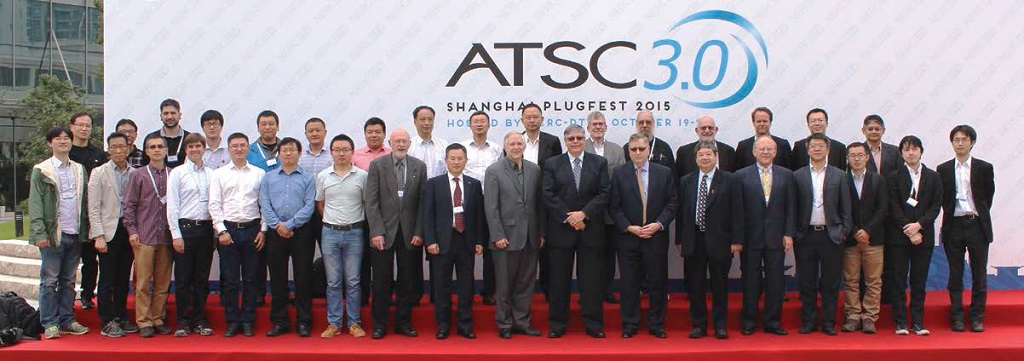
The two-day ATSC Plug Fest in Shanghai attracted a number of distinguished television engineers from around the world.
Plug Fest Also Demonstrates LDM
A specially equipped van offered Plug Fest attendees a real-world demonstration of the capabilities of ATSC 3.0.
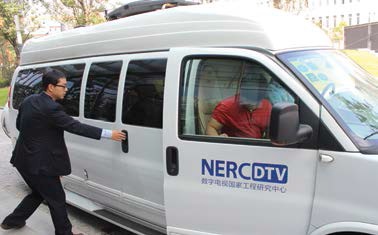
Layered division multiplex (LDM) is a very recent development in the evolution of the ATSC 3.0 DTV standard and will provide broadcasters with the ability to control over-the-air signal characteristics to favor different types of viewing devices and environments. An extremely robust signal—but with resolution tailored for portable handheld devices—can be transmitted, while at the same time a very high quality content stream—but without the enhanced robustness—can be sent to large screen HD displays in less challenging (fixed) environments.
So far, LDM demonstrations have been mostly confined to laboratory environments. However, a real-world demonstration of the technology’s capabilities was offered to participants at ATSC’s Shanghai Plug Fest. An equipment package constructed by ETRI engineers and fitted into an NERC-DTV van was used to dynamically demonstrate LDM’s capabilities. The package included a spectrum analyzer and a prototype ATSC 3.0 receiver which broke out LDM “upper” and “lower” layers. The upper, more robust, signal was routed to a small tablet and the higher-quality lower layer output was fed to a large screen HD display. A signal was provided from a low-power (40 Watt) UHF transmitter with the transmitting antenna located several stories above ground level.
An equipment package constructed by ETRI engineers and fitted into the NERC-DTV van was used to dynamically demonstrate LDM’s capabilities.
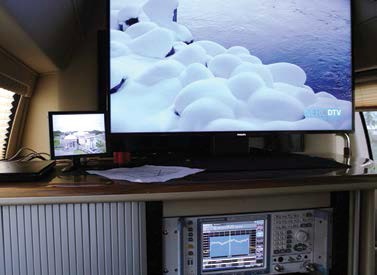
Once the van started moving around the NERC-DTV complex, the received RF signal level rather predictably began to vary. Initially, both displays provided stable images; however, as the van began to move in Shanghai traffic and around high-rise buildings, signal variations became more extreme. Video on the large-screen monitor alternately froze or disappeared completely; however, the tablet picture remained stable throughout the several kilometer path followed by the van, providing a dynamic and convincing indication that LDM really works.
James O’Neal
Michael said that he anticipated additional testing events as additional portions of ATSC 3.0 reached candidate status and this was echoed by Richer. “I think there’ll be more industry Plug Fests of the physical layer and also the other layers and I think they’ll all be big events,” he said. “There are also going to be companies working privately doing their own internal tests with different products. There’s a lot we won’t see, but we’ll know what’s going on because we’ll hear about the different issues that are identified as those events move forward.”
Richer also praised the assistance and cooperation received from the NERC-DTV group and others in connection with the testing.
“They did a really fabulous job,” said Richer. “It was just amazing the amount of resources the NERC-DTV put into the testing.”
MULTICOUNTRY MISSION
The Shanghai Plug Fest marked the final stop for Richer and others associated the ATSC. He described visits in Japan and Korea that were part of the association’s “Far East” mission.
“Japan was our first stop and we met with our colleagues at NHK and it was a wonderful meeting,” said Richer. “ATSC has worked with NHK for a long time and NHK has been a big contributor to the development of ATSC 3.0. We were happy to go to Japan and hear about their plans. NHK is really focused on 8K satellite and cable transmission and reception, so that’s really going to be moving things forward in terms of technology in a few years. We’re focused more on terrestrial delivery of 4K, but there is a lot of collaboration between the NHK team and the others in ATSC. We also met with Sony to talk about their plans and to thank them for their efforts. Sony has really shown a lot of leadership in the development ATSC 3.0.”
Reflecting on the ATSC’s visit to Korea, Richer said, “we have a very good relationship of course with many organizations in Korea. Korea adopted the ATSC 1.0 standard and has developed a lot of technology for that standard. They’ve made a lot of contributions to ATSC 3.0. Samsung, LG and ETRI, as well as others in Korea have been working hard to make ATSC 3.0 a success. The focus in Korea is getting on the air with ATSC 3.0 and being able to provide 4K services during the 2018 Olympics in Seoul, so they are very focused on their goal of getting on the air with ATSC 3.0. At this point it’s very likely that Korea will have the first commercial broadcasts services in ATSC 3.0, and we will work with them to make sure that that becomes a reality.”
James O’Neal is a retired broadcast engineer and current technology advisor forTV Technology.
